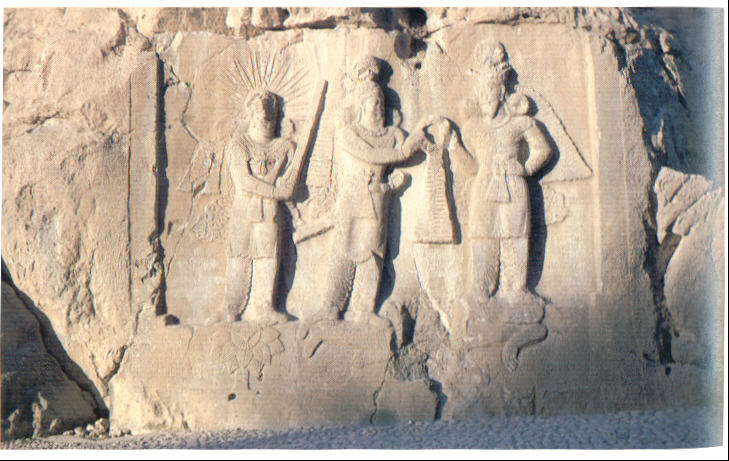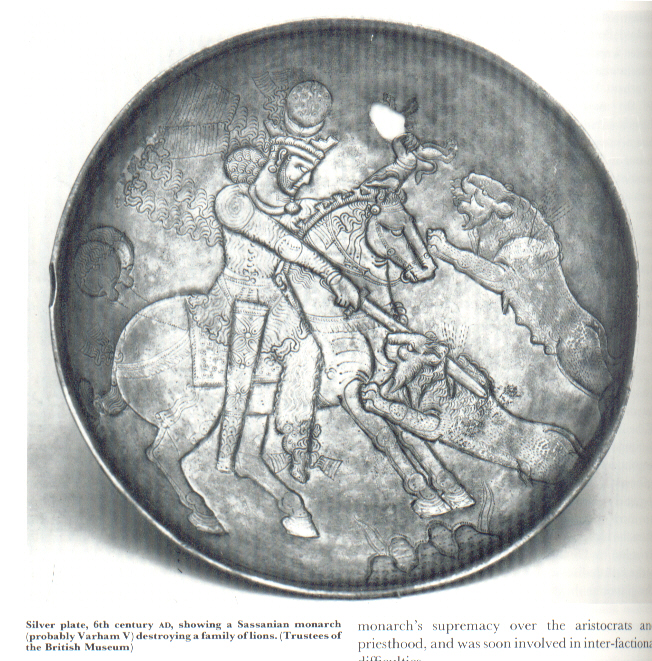In A.D. 224 Ardashir Babakan defeated at Hormouzdgan the Parthian
emperor Artavan V and managed to become the ruler of the whole Parthian
empire. Two years later Ardashir was crowned in Ctesiphon as Ardashir I
and became the founder of the Sasanian dynasty on the throne of Persia.
This event would change the historical face of Persia for the next four
centuries. The Sasanian empire replaced the Parthian and the main effort
of Ardashir and the other Sasanian kings after him was to establish and
preserve a strong state which would be characterized by the glory of the
Achaemenid Kings. Ardashir reorganized the empire by introducing several
changes in every important branch of his empire. In his time the Zoroastrian
religion acquired more power and influence and the high clergy of the religion
became one of the three most important political factors in the empire.
The high priests were the official representatives of the Shahan Shah to
the satrapies of his empire. The govermship depended on the duties of the
local rulers and the decisions of the central government.

Shahpuhr I, Ardashir’s son, took advantage of the prosperity
brought to the empire by his father and decided to wage a war against Rome.
In A.D 260 he managed to capture the Roman emperor Valerianus and his son
Gallianus. Both of them died in captivity. During his reign Mani Khayyan
created his religious heresy, Manichaeism, which opposed to the official
dogma of Zoroastrianism. The whole empire was shocked by Manichaeism but
in the end the followers of this heresy were exiled to the eastern part
of the Sasanian empire near Chinese provinces. During the reign of Vahram
I and Vahram II (till A.D. 302) the influence of the Zoroastrian clergy
was dramatically increased because of the presence of Kartir, the Mubadan-i
Mubad (=Great Priest). The decisions for serious matters related to the
empire were not taken without Kartir’s opinion. The strength of Zoroastrian
religion became greater, especially in religious, political and financial
matters.
The reign of Shahpuhr II is widely characterized as the
start of the golden age for the Sasanian Empire. He was a strict King but
also very capable of ruling such an enormous empire. He reigned for 70
years (325-379) and remained in history as the greatest military leader
in the Sasanian Era.
He managed to eliminate all the enemies of Persia in its eastern borders
and show a strong face towards the great enemy of Persia, the Roman empire.
His state was extended from Chinese borders to Mesopotamia and from Caucasus
Mts. to Punjab. The influence of the clergy became less due to the policy
he followed. The image of Sasanian empire was improved and its power was
approved by the rest of the world. However the predecessors of Shahpuhr
II (Ardashir II, Ardashir III, Shahpuhr III) did not achieve anything that
could compare them with Shapuhr II.
During the reign of Yazdgird I
the peace with Roman Empire was the main aim of the Sasanian King, an aim
finally achieved. The diplomatic relations between Sasanian empire and
Constantinople are considered friendly and peaceful while at the same time
Yazdgird I followed a liberal policy for the religious minorities of his
empire. Yazdgird’s son, Bahram V Gur is known more for his glamorous feasts
in his palace than for his battles against the enemies of his country.
He was a king keen on the literal way of life. He lived in an easygoing
way at the top of the golden age of the Sasanian period.
Piruz I lived in a different way by spending
most of his time in the battle. He faced the invasions of the White Huns
to the North Eastern borders of his empire. In 484 he was slaughtered by
the Great Khaghan of the Huns. Valash was the prince chosen from the aristocracy
and the clergy to sit on the throne taking the place of Pirouz. Valash
was not a strong character and aristocrats and the clergy were aware of
his weakness. It was a great opportunity for them to strengthen their influence
concerning the control of the political power.
However, Kavadh I had a different opinion. In A.D.
488 was crowned King of the Sasanian state. He was a supporter of the social-religious
sect of Mazdak and a persona friend of the leader of the new heresy. The
tuition of Mazdakism was opposed to the power of the aristocracy and the
clergy. Kavadh decided to make several reforms, evidently influenced by
Mazdak. The Bozorgan (Aristocrats) and Mubadan (Clergy) waged propaganda
against the Sasanian King. They forced him to abandon the throne and placed
Jamasp, his brother, on the throne. Kavadh took refuge in the court of
the Hun King and after almost 2 years he returned to the throne based on
the support of the Huns. This time he knew that he had to change his policy,
he stopped supporting Mazdak. In this second part of his reign he succeeded
in approaching the clergy and the aristocrats and tried hard to reorganize
his state with several reforms in order to strengthen it.

Khusraw I Anushirwan (=Immortal
Soul) was the last great Sasanian King. During his reign (A.D. 531-579)
the prosperity of the Sasanian empire reached its height in every part.
He fought against Justinian I and managed to sign beneficial for his empire
agreements with the Romans. He conquered Yemen establishing a new era for
the commercial power of Persia in the Red Sea. Glorious buildings, like
the Great palace in Ctesiphon, were created. The first university was established
at Gondishapour and the literary production of this period is doubtless
(e.g the book Kalila va Damaneh). He ruled in an absolute way, being at
the same time popular. The influence of the clergy became less by his policy.
Doubtless it could be supported that Khusraw Anushirwan’s reign was an
Iranian renaissance.
However the effort of Khusraw I was only temporary.
His predecessors failed to continue the achievements of his reign. On the
contrary the civil conflicts in the Sasanian empire lead gradually the
state to the decline and fall. The reign of Khusraw II Parwiz was a period
with many contradictions. Khusraw II wanted to be the first Sasanian king
who would conquer all those lands that had been conquered by Darius I Histaspa
in the 6th B.C. The lack of stability in the Byzantine Empire gave the
Sasanian King the chance to wage a war against the great enemy. Khusraw
managed to conquer Syria, Palestine, Egypt and a large part of Asia Minor.
The dream of the revival of the Achaemenid glory was a reality. However,
this reality would not last for long.
The Byzantine Emperor Heracleius waged a campaign
against Khusraw II Parwiz and this campaign would be colored in a religious
way because of the capture of the Holly Cross by the Sasanian troops in
Jerusalem (615). The Persian-Byzantine war would end in 627 with the defeat
of the Persian troops. Khusraw II was murdered in 628 and was succeeded
by his son Shiroyye.
The last two decades of the Sasanian
era were a real decay for the empire. Kings with insufficient and improbable
personality to rule lead the empire faster to the destruction. The only
exception was Yazdgird III, the last Sasanian king who tried to save its
state from the destruction. His financial and military reforms were remarkable
but it was too late for Yazdgird III to change the fate. The battle of
Nihavad (642) and the last battle of Qadisiya (651) were the two events
that sealed the end of the Sasanian era.
Islam, the new religion, would
change the fate of Iran and a new chapter in the Iranian history would
be written. (*)
(*) The chapter concerning the Islamic period in Iran is to be
written.
|

